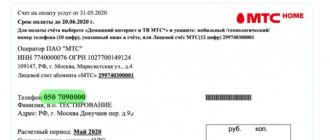Every phone connected to the Megafon network wonders how to set up the Internet? Without the correct settings, it will be impossible to use the network and MMS. This applies to both regular phones and widely used smartphones.
When you install a SIM card in any modern mobile device, it is configured automatically. However, sometimes it happens that the settings themselves were not installed or were not registered - then you need to configure the phone manually. This review will tell you how automatic configuration occurs, as well as how to enter the settings yourself.
Ordering Internet settings from Megafon
Using SMS commands, the user can get Megafon Internet settings for his phone. If you need to set up access, you need to send the number “1” to 5049 , after which you will receive an SMS containing your profile settings. You need to save them and activate your profile, then try to log into the network. On Megafon, GPRS settings are also available in the help desk; to do this, dial the number 0500, name the model of the phone you are using and wait for a service SMS with the settings.
By visiting the Megafon website, in the Self-Service Services section, you can find another subsection with Mobile Device Settings, in which you can order individual settings suitable for any mobile phone model. We select the phone brand, model, as well as the ordered data in the drop-down lists, below we enter the phone number used to send the required settings.
Internet settings Megafon manually
APN (or access point) settings on Megafon can be done manually. To do this, a new profile is created on the phone containing the following data:
- Profile name: indicate, for example, Megafon (absolutely any names are acceptable here);
- Home page: type megafon.ru (you can also enter any address, since this setting concerns the home page used by the browser built into the phone);
- Access point: enter internet;
- Authentication: select “normal”;
- Login with password: no need to fill out.
There may be settings for a proxy server, but it is recommended to disable the use of a proxy; you do not need to fill in any data here. After filling out the specified settings, by opening the browser, you can try to launch the Internet on your phone.
If you need to figure out how to set up the Internet on Megafon using 3G technology, then there is no need to make additional settings for the third generation network, just go to the item called “Mobile network properties” and check that there is a search for the WCDMA network (or the forced registration function is installed for WCDMA networks).
When performing the above settings, remember that the menu item in which the Internet profile settings are located may differ depending on the specific smartphone model. In addition, there may also be differences in the names of the fields to be filled in, for example, “Access Point”, as well as “APN” - this is a similar name.
Operator description
Megafon is one of the main Russian cellular operators. The company has been on the market for more than 20 years. It has branches in all regions of Russia. The subscriber base numbers more than 77 million people. In scale it is comparable to MTS and Beeline. This is an innovative company: it was the first to introduce 3G, 4G, 4G+ (speed up to 300 Mbit/s), LTE, LTE Advanced communication standards in Russia.
Megafon 3G and 4G coverage area
Before turning on the Internet from Megafon, you should first make sure that you will receive a 3G or 4G signal in places where you will constantly be with a smartphone, USB modem, tablet or router. The 3G network is weaker than 4G, but it can be used even in areas remote from the city.
Judging by the map, Megafon covers almost all populated areas of the country (even small ones) with a 3G network. 4G can only be found in cities. You can take a closer look at Megafon's coverage map on its official website using this link.
Megafon covers almost the entire country with a 3G network
Setting up MMS on Megafon
The procedure for setting up MMS for the Megafon operator is almost identical to ordering for the Internet. To get a working function that allows you to receive and also send multimedia MMS messages, you need to send the number “3” to the number 5049. After a short time, a message will be sent to your phone containing the necessary settings: you need to save them, then apply them and try to send an MMS to any Megafon number. In the same way, you can order automatic settings through the Megafon website, having previously selected your phone model from the list provided there.
Tele2 access point
The process of creating an access point when purchasing a new SIM card from a given operator is in many ways similar to the examples discussed above. Features of manual configuration will be presented below.
Auto-tuning
To cope with this task, you need to log into your personal account using your phone number and read the manual for automatically configuring an access point. Most likely, you will need to call the operator, after which he will send a message with detailed instructions. Here the user will only have to click on the “Save” button.
OS Android
To complete this task it is necessary:
- Open the settings menu.
- Click on the “Mobile network” option.
- Find “APN” in the list provided.
- Enter the combination “internet.tele2” opposite this line.
- Reboot your smartphone.
On iPhone
On OC iOS the procedure is performed in a similar way. However, before changing the APN settings, it is important to enable LTE mode on your phone.
Windows Phone
The task of creating an access point on this system is performed according to the standard algorithm:
- Open device settings.
- Enter the “Data Transfer” section.
- Configure APN according to the scheme discussed above.
Important! In the process of changing APN parameters, the Tele2 operator may encounter difficulties. If an error occurs, you need to contact your telecom operator.
Tele2 operator SIM card
Setting up MMS on your phone manually
In cases where you cannot accept the automatic settings or install them, you will have to enter the settings manually. To do this, create a profile on your phone, indicating the data below:
- Profile name: you can simply type MMS (you can enter anything);
- Server address or home page: indicate https://mmsc:8002 (no changes);
- Proxy: must be “enabled”;
- Proxy address: enter the numbers 10.10.10.10;
- Port field for the proxy used: 8080;
- APN (or the name may be “Access Point”): mms;
- The user and password fields do not need to be filled in.
As with setting up an Internet profile, some items may have different names depending on the smartphone you are using.
It doesn’t matter who you are... it matters what your APN is!
This article will talk about a small trick that a certain virtual OpCoS can resort to in order to deceive its subscribers in the process of providing packet data services. Our focus will be on the process of selecting and using an Access Point Name [APN]. As we remember from the article GPRS from the inside. Part 2, APN is used during the PDP Context activation procedure and is intended to determine the service requested by the subscriber. Services provided by the mobile operator's packet network resources can be:
- Mobile internet
- Intranet VPN access
- MMS
- Wap
- LAN over GPRS
- PTT [Push-To-Talk]
- SMS over GPRS*
* - to provide services for sending short messages, APN is not used and there is no need to activate PDP Context; it is enough to carry out the GPRS Attach procedure.
Let's take a closer look at the mechanisms for selecting and using APN(en) - Access Point Name in a GPRS session. Let's start with the restrictions, APN NOT
:
- end with '.gprs'*
- have special characters in the name (? % # $ *)**
- be less than 1 character and more than 63 characters*
- start with combinations of character sequences: LAC, RAC, SGSN, RNC
- start with operator code (see below)
* - this limitation applies to the so-called
Network ID (see below) ** - only alphanumeric sequences of characters are used: 'A... Z', 'a... z', '0... 9', as well as the symbols '. -' The APN must also start with an alphanumeric character sequence and is not case sensitive on the SGNS side.
Functionally
APN is intended to determine the IP address of the GGSN, which will provide the service requested by the subscriber when activating the PDP context.
Optionally,
the APN consists of two parts - the network identifier (mandatory part) and the operator identifier (optional part):
- the network identifier determines the IP address of the GGSN or several GGSNs and, to a first approximation, determines the type of network to which the GGSN has an outlet;
- operator identifier represents the parameters of the operator network in which the serving GGSN is located and consists of MNC and MCC (for example, mnc009.mcc255.gprs - some operator, Ukraine - which is also called GOI), if this data is not in the APN name, then for subscribers of the operator's home network SGSN will add the so-called Default APN Operator Identifier, specified in SGSN for the subscriber's home network, the so-called. HPLMN*;
* - for a mobile network subscriber, there is the concept of a home network [HPLMN], i.e. network in which the tariffs specified in the contract for the provision of network services will apply, but there is also the concept of a guest or roaming network [VPLMN], in which tariffs will apply according to the roaming agreement between operators. In this case, there will be only one home network for the subscriber, but there may be several guest networks.
The operator ID can be added to the APN in various ways:
- Received from the subscriber upon activation of PDP Context (registered in the APN itself).
- Generated from the subscriber's IMSI if the guest user is roaming and requests access to his home network.
- Obtained from the GOI parameter, which is registered on the SGSN for the network to which the subscriber belongs
The full APN name (including the operator ID) is used to resolve the IP address of the GGSN that will serve the specified APN.
On the side of the local DNS operator, the APN will be “decrypted” from right to left, i.e. the service area of the gprs domain is determined, then the service area of the mcc255 domain, etc. Before activating the PDP Context, the SGSN receives a user profile from the HLR. In the user profile, the APN parameter can indicate the APNs allowed for use by the subscriber, or the “*” icon can be indicated, which allows the use of any of the existing APNs in the operator’s network. If a profile contains a list of several allowed APNs, then the first APN in the list has higher priority than the rest - see examples. For each PLMN, be it Home PLMN or Visitor PLMN, most vendors allow you to register on SGSN, the so-called. Default APN Operator Identifier [DEFAPN], which is automatically substituted as the Network Identifier, i.e. actually replacing the APN requested by the subscriber, but only if the subscriber misspelled the APN or specified an APN that does not exist in the operator’s network. The main idea of using the DEFAPN parameter is aimed at reducing the number of unsuccessful attempts to activate the PDP Context if subscribers made a mistake, i.e. You specified the wrong APN in the connection settings. The use of the DEFAPN parameter is optional and does not affect the overall functionality, i.e. The operator may not purchase licenses to use this functionality. In addition to the DEFAPN settings, usually a mandatory setting on the SGSN is permission to overwrite the requested APN [Override of the requested APN], as well as separate settings for replacing the requested APN for roaming subscribers.
But what prevents the operator from using additional functionality to his advantage... 
The scenarios for the development of events are almost the same for both roaming subscribers and subscribers located in their home network, the only difference is that the parameters for replacing the requested APN must be specified for the PLMN to which the user belongs (i.e., either HPLMN or VPLMN) therefore, all of the following is equally applicable to both scenarios of a subscriber being in a roaming network (VPLMN) and in a home network (HPLMN).
- Smart subscriberGiven:
the subscriber specified in the phone settings an existing APN (for example, opsos.com.ua), to which he is allowed access. His profile on HLR contains a list of APNs allowed to him (for example, in this order - internet, opsos.com.ua, mms.opsos.com.ua).- DEFAPN
Activated,
Override of Requested APN
Permited
The subscriber is in his home network:
to the requested APN SGSN will add the GOI specified for HPLMN (i.e. for our virtual operator it is mnc009.mcc255.gprs), by the full APN name - opsos.com. ua.mnc009.mcc255.gprs will resolve the IP address of the GGSN, which will serve the GPRS session.
PDP Context for the subscriber will be successfully activated according to the APN specified by him (in our case it will be opsos.com.ua), the tariffs for using packet transmission will correspond to the tariffs of the opsos.com.ua access point. The subscriber is in the guest network:
in the guest network, SGSN will add the home network GOI to the specified APN name, based on information from the IMSI, send a request to the DNS server and receive the GGSN IP address in the operator’s home network, then redirect the PDP Context to the subscriber’s home network, i.e. .e. When roaming, subscribers use the roaming SGSN, but all traffic passes through their “home” GGSN. Tariffs for using packet transmission will correspond to the roaming tariffs of the opsos.com.ua access point for the subscriber. - DEFAPN
NOT Activated,
Override of Requested APN
NOT Permited Further developments are almost similar for both roaming subscribers and subscribers in their home network (HPLMN), so we will not consider the two scenarios, but will only point out the main differences. In this scenario, nothing will change, the subscriber will be able to activate PDP Context using the APN - opsos.com.ua, the tariffs for using packet services will correspond to the tariffs of the opsos.com.ua access point. - Typical subscriberGiven:
the subscriber specified an existing APN in the settings, for example - internet (or any other APN existing in the operator’s network), while in the subscriber’s settings on HLR (in his profile) “*” is indicated in the APN parameter.- DEFAPN
Activated,
Override of Requested APN
Permited The subscriber will be able to activate PDP Context using the APN he specified - internet, the tariffs for using packet services will correspond to the tariffs of the internet access point, because The DEFAPN parameter does not participate in any way in activating the subscriber context. - DEFAPN
NOT Activated,
Override of Requested APN
NOT Permited The subscriber will be able to activate PDP Context using the APN he specified - internet, the tariffs for using packet services will correspond to the tariffs of the internet access point. - Almost smart subscriberGiven:
the subscriber specified in the phone settings
NOT
an existing APN (for example, mega.fast.internet), or the subscriber will specify an existing APN in the settings, but which will not be present in the list of allowed APNs in the subscriber profile with HLR. His profile on HLR contains a list of APNs allowed to him (for example, in this order - internet, opsos.com.ua, mms.opsos.com.ua).- DEFAPN
Activated
Override of Requested APN
Permitted In this case, because on the SGSN side, the subscriber profile from the HLR will be received, the first APN in the list will be determined and the PDP Context will be activated using this first APN.There is a small nuance here, because... the subscriber does not have the right to somehow interfere with changing his profile, that is, it is likely that the first APN in the list of APNs allowed for him will be an APN whose usage rates will turn out to be not very low.
DEFAPN
NOT Activated,
Override of Requested APN
NOT Permited In this case, the user will receive a Reject to activate the PDP Context and will not be able to use the requested service until he specifies one of the APNs specified in his profile with HLR. - DEFAPN
- “Gifted” subscriber + a little trick (read LOYALTY) of the operatorGiven:
the subscriber hears the word APN for the first time (or indicated a non-existent APN / made a mistake when entering an existing APN), in his HLR profile “*” is set instead of APN.- DEFAPN
Activated
Override of Requested APN
Permited Let's assume that in the default settings of SGSN for subscribers of the PLMN to which the subscriber belongs, for example, DEFAPN - expensive.net is installed with the “cheapest” (let’s say, packet data transfer under APN expensive.net is the most expensive tariff in the operator’s network) tariffs for using packet transfer data. In this case, because If the subscriber did not specify the “correct” APN, then his requested APN will be replaced with the one specified in DEFAPN, i.e. - expensive.net.Here another “nuance” appears: if a subscriber connects to the network under the specified conditions, then he will pay, i.e. at the expensive.net rate.
DEFAPN
NOT Activated,
Override of Requested APN
NOT Permited In this event scenario, the subscriber will receive a Reject to activate the PDP Context and will not be able to use packet data services. - DEFAPN
Actually, with the help of such small tricks, our virtual cellular operator can deceive its subscribers.
Conclusion:
Always control the settings and parameters that are transmitted in any communication, including when using GPRS/EDGE services in mobile operator networks, because very often messages pop up online about dissatisfaction with data services and high bills for using mobile communications, and sometimes it’s very, very difficult to get some kind of sane answer from the operator.
Z.Y.:
During the writing of this article, not a single cellular subscriber was harmed, because... in our country all operators are “honest” and fluffy 
A little helper:
APN
— Access Point Name
GGSN
— Gateway GPRS Support Node
GOI
— GGSN Operator Identifier
GPRS
— General Packet Radio Service
HLR
— Home Location Register
HPLMN
— Home PLMN
IMSI
— International Mobile Subscriber Identity
LAC
— Location Area Code
MCC
— Mobile Country Code
MNC
— Mobile Network Code
PDN
— Packet Data Networks
PDP
— Packet Data Protocol
PLMN
— Public Land Mobile Network
RAC
— Routing Area Code
RNC
— Radio Network Controller
SGSN
— Serving GPRS Support Node
VPLMN
— Visitor PLMN
Related links (en):
- 3GPP TS 23.003 Numbering, addressing and identification
- PLMN supporting packet based services and PDN
Setting up the Internet on Megafon 3G (4G) modems
Such popular 3G and 4G modems offered by Megafon are usually sold with settings already made: after purchasing the device, it is connected to any USB port, after which you need to wait for the installation to complete, which is launched automatically by the modem’s control program. After this, everything is ready to go online.
If the data that was present in the automatically created profile was lost, then you can configure the Megafon-modem manually. To do this, you need to create a profile and it states the following:
- Profile name: specify any name, for example Internet Megafon;
- Access point or APN: internet;
- Number to call: dial *99# in the field;
- The username and password field is not required.
You are now ready to check if you have an Internet connection.
Rostelecom access point
One of the most common television and Internet providers. The company also provides communication services. The process of setting up an access point will be discussed below.
Rostelecom access point, adjusting APN parameters
Auto-tuning
By using the services of this operator, the user will not have to install an auto-tuning package. This procedure is performed by an employee of the retail store where the SIM card was purchased. After this, you just need to insert the SIM card into your mobile phone and you can go online.
OS Android
This procedure is performed according to the algorithm:
- Launch the options menu.
- Tap on the “More” section.
- Click on “Mobile network”.
- Enter “internet.rtk.ru” in the “APN” field.
- Apply changes and reboot the device.
Manual setup on iOS
It is carried out according to a similar scheme discussed above. The “APN” field also contains the rtk.ru login and password. It is customary to leave the “Username” line empty.
Windows Phone
To carry out the procedure, you can use the algorithm:
- Launch the main screen and open the smartphone settings.
- Tap on the “Data transfer” item.
- Click on "APN".
- Register your login and password in the same way.
- Reboot your phone.
Note! In some cases, restarting the gadget is not enough. You will need to turn it off for a few minutes, or better yet, remove the SIM card from the tray.
Data Transfer option on Windows Phone
How to connect the device?
In order to configure the device, you need to connect to it. This can be done in two ways:
- Via Wi-Fi.
- Via a USB cable that will be connected to a computer or laptop.
WiFi
- Fully charge your device and turn it on.
- On your phone, tablet, or laptop, tap Search for wireless networks.
- The default network name and password are under the cover. Carefully remove the cover and look at the back for this information.
By wire
Just plug one end of the cable into your router and the other USB into your computer or laptop. Driver installation should happen automatically in the background.











